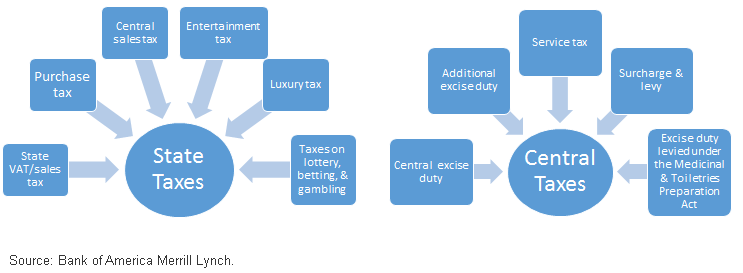Earlier in August, as U.S. investors were preoccupied with domestic news on the elections and markets, an interesting development happened halfway around the globe. India’s legislature, after a notoriously long process, approved one of most ambitious tax reforms in history—the Goods and Services Tax (GST) bill.
Overall, GST is India’s attempt to create the largest marketplace with standardized tax rates ever. It is also a reminder of the Modi government’s serious push for reforms to make it easier to do business in India. Most of India’s macro factors have improved recently, earnings of corporate India are steadily improving, and the central government is gradually pushing positive policy changes.
So, let’s take a look at what GST is and how it affects various sectors of the Indian economy.
What Is GST?
Broadly speaking, governments collect revenues/taxes in two categories:
• Direct taxes or taxes paid by individuals (e.g., income tax, wealth tax, capital gains tax, etc.) or corporations (e.g., corporate tax)
• Indirect taxes or taxes collected by intermediaries (e.g., retail stores) in lieu of goods or services purchased or sold, like a sales tax or
value-added tax (VAT)
Typically, in developing countries, indirect taxes make up a greater portion of total taxes. In the U.S., taxes on goods and services are 5%
1 of total tax collection, while in India they account for over 30%.
2
India’s GST is a bold attempt to streamline these indirect taxes and increase tax compliance. Taxes in India are split into an array of federal and state taxes. Not only does every state have its own rate, but each could also levy extra taxes depending on the category of sale (e.g., luxury taxes on high-end hotels, entertainment taxes on movies).
GST aims to subsume these taxes under two distinct categories of central and state tax, as shown in the chart below.
Taxes Subsumed by GST State and Central Taxes
 What Does GST Aim to Do?
What Does GST Aim to Do?
•
Create uniform taxes across states: This allows firms to base logistics decisions purely on a business basis and not on tax
arbitrage, thus improving business efficiency.
•
Eliminate the cascading impact of taxes: Currently, businesses need to pay taxes separately to several tax collecting authorities (especially if operating across states), and claiming tax credits is very difficult. This results in manufacturers baking these costs into the price of the product. It is expected expect prices of manufactured items to decrease under GST.
•
Create less red tape and paperwork, with enhanced governance: GST will eliminate taxation layers as goods and services move across borders, with the intention of reducing red tape and increasing tax compliance. It will also incentivize dealers to request documentation to claim tax credits from the dealer behind them in the value-added tax chain.
•
Level the playing field for organized shops: India’s huge consumer market is highly fragmented: 66% of the $185 billion
3 consumer goods market is compiled of un-established brands. As overall taxes come down, organized firms will become more competitive compared to unorganized firms, which tend to keep costs lower by evading taxes. Simultaneously, centralized tax collection will put more pressure on unorganized firms to pay taxes.
With GST, India stands to have a seamless movement of services and merchandise throughout the country.
What Is GST’s Impact on Economic Sectors?
The key principle of GST is to unify taxation of value-added activities. Currently, manufacturing firms pay
excise tax of 14% collected by the central government, a VAT of 12.5% (both without exemptions)
4 collected by states, and an entry tax collected by municipal corporations. As taxes are streamlined, the overall rate (still being debated) is likely going to be 18% (9% for central GST and 9% for state GST).
5 Total indirect taxes will come down to 18% from the current three components of 14% + 12.5% + entry taxes. The price of goods should naturally come down.
Below are a few sectors affected by GST:
•
Sectors Affected Positively: Consumer Durables, Industrials and Manufacturing & Materials
- For manufacturing sectors and consumer durables, the effective tax rates come down, making end products cheaper. For example, the effective tax rates for automobiles come down from as high as 47% to around as low as of 20%.6
- Increased transportation, truck utilization, and interstate flow of materials plus the price differential between organized and unorganized mining/materials industries would have a positive impact on materials.
•
Sectors Largely Unaffected: Information Technology, Health Care & Pharmaceuticals and Telecom
- Information Technology industry earns a large part of its revenue from exports, which may continue to be exempt under GST.
- Taxes on software could potentially go up.
- A concessional tax bracket for the pharmaceutical sector is expected to continue under GST, thus no changes.
- For telecom companies, the effective tax rate under GST would go up a little bit from the current 14%.7 Telecom companies may pass a part of this increase to the end consumer, so the impact is largely neutral.
•
Sectors Affected Negatively: Financial Services and Energy
- Currently, banks pay a service tax to the central government. In GST, a service tax would be paid to states. Thus, banks would have to break down large, complex transactions and keep track of states where they happened, resulting in higher tax compliance and audit costs.
- Petroleum products (and alcohol) are initially excluded from GST. A refiner producing diesel will pay GST on procurement of its equipment and would not get tax credits against its regular excise duty and VAT.
We believe India may have the most long-term potential among emerging markets. Investors willing to take the risk stand to benefit from the long-term upside that India offers, in our view.
1Source: World Bank, as of 08/19/2016.
2Source: World Bank, as of 08/19/2016.
3Source: Bank of America Merrill Lynch.
4Source: Bank of America Merrill Lynch.
5Source: Economic Times, India.
6Source: Economic Times, India.
7Source: Economic Times, India.
Important Risks Related to this Article
Investments focused in India increase the impact of events and developments associated with the region, which can adversely affect performance.
International investing entails special risk considerations, including currency fluctuations, lower liquidity,economic and political risks, and differences in accounting methods; these risks are generally heightened for emerging market investments.
There are also risks associated with investing in India, including the risk of investing in a single-country fund. Concentrating investments in the India region subject a fund to more volatility and greater risk of loss than geographically diverse funds.
Equity stocks of small and mid-cap companies carry greater risk, and more volatility than equity stocks of larger, more established companies


 What Does GST Aim to Do?
• Create uniform taxes across states: This allows firms to base logistics decisions purely on a business basis and not on tax arbitrage, thus improving business efficiency.
• Eliminate the cascading impact of taxes: Currently, businesses need to pay taxes separately to several tax collecting authorities (especially if operating across states), and claiming tax credits is very difficult. This results in manufacturers baking these costs into the price of the product. It is expected expect prices of manufactured items to decrease under GST.
• Create less red tape and paperwork, with enhanced governance: GST will eliminate taxation layers as goods and services move across borders, with the intention of reducing red tape and increasing tax compliance. It will also incentivize dealers to request documentation to claim tax credits from the dealer behind them in the value-added tax chain.
• Level the playing field for organized shops: India’s huge consumer market is highly fragmented: 66% of the $185 billion3 consumer goods market is compiled of un-established brands. As overall taxes come down, organized firms will become more competitive compared to unorganized firms, which tend to keep costs lower by evading taxes. Simultaneously, centralized tax collection will put more pressure on unorganized firms to pay taxes.
With GST, India stands to have a seamless movement of services and merchandise throughout the country.
What Is GST’s Impact on Economic Sectors?
The key principle of GST is to unify taxation of value-added activities. Currently, manufacturing firms pay excise tax of 14% collected by the central government, a VAT of 12.5% (both without exemptions)4 collected by states, and an entry tax collected by municipal corporations. As taxes are streamlined, the overall rate (still being debated) is likely going to be 18% (9% for central GST and 9% for state GST).5 Total indirect taxes will come down to 18% from the current three components of 14% + 12.5% + entry taxes. The price of goods should naturally come down.
Below are a few sectors affected by GST:
• Sectors Affected Positively: Consumer Durables, Industrials and Manufacturing & Materials
What Does GST Aim to Do?
• Create uniform taxes across states: This allows firms to base logistics decisions purely on a business basis and not on tax arbitrage, thus improving business efficiency.
• Eliminate the cascading impact of taxes: Currently, businesses need to pay taxes separately to several tax collecting authorities (especially if operating across states), and claiming tax credits is very difficult. This results in manufacturers baking these costs into the price of the product. It is expected expect prices of manufactured items to decrease under GST.
• Create less red tape and paperwork, with enhanced governance: GST will eliminate taxation layers as goods and services move across borders, with the intention of reducing red tape and increasing tax compliance. It will also incentivize dealers to request documentation to claim tax credits from the dealer behind them in the value-added tax chain.
• Level the playing field for organized shops: India’s huge consumer market is highly fragmented: 66% of the $185 billion3 consumer goods market is compiled of un-established brands. As overall taxes come down, organized firms will become more competitive compared to unorganized firms, which tend to keep costs lower by evading taxes. Simultaneously, centralized tax collection will put more pressure on unorganized firms to pay taxes.
With GST, India stands to have a seamless movement of services and merchandise throughout the country.
What Is GST’s Impact on Economic Sectors?
The key principle of GST is to unify taxation of value-added activities. Currently, manufacturing firms pay excise tax of 14% collected by the central government, a VAT of 12.5% (both without exemptions)4 collected by states, and an entry tax collected by municipal corporations. As taxes are streamlined, the overall rate (still being debated) is likely going to be 18% (9% for central GST and 9% for state GST).5 Total indirect taxes will come down to 18% from the current three components of 14% + 12.5% + entry taxes. The price of goods should naturally come down.
Below are a few sectors affected by GST:
• Sectors Affected Positively: Consumer Durables, Industrials and Manufacturing & Materials


